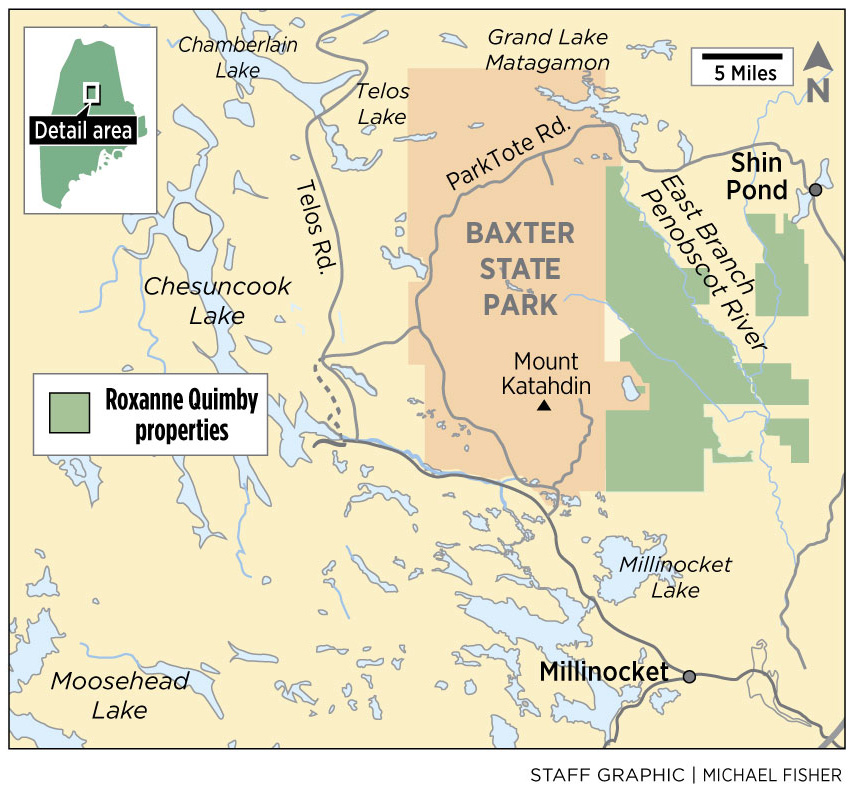Roxanne Quimby’s foundation donated more than 87,500 acres in the Katahdin region to the federal government Tuesday in a critical step toward creation of a national monument in Maine’s North Woods.
While representatives for Quimby and the Obama administration remained silent Tuesday about a potential national monument designation, news of the land transfers drew strong reactions from those involved in a debate over the changing use of Maine’s vast forestlands. Supporters cheered a gift that they predicted could revitalize the region’s struggling towns, while opponents warned that providing a foothold to the federal government would inhibit economic development in the North Woods.
“It’s a sad day and a crying shame,” said Mark Marston, an East Millinocket selectman and vocal critic of the monument plan. “I think it’s just a pathway for a larger (national) park down the road.”
Documents posted Tuesday morning on the Penobscot County Registry of Deeds showed that Quimby’s nonprofit, Elliotsville Plantation Inc., had transferred 87,654 acres to the U.S. Department of the Interior. The documents were signed by Quimby and Rachel McManus, a deputy realty officer for the Interior Department, which oversees the National Park Service. The land is located to the east of Baxter State Park, which totals roughly 209,000 acres. Much of the transferred land abuts Baxter.
The move could allow President Obama to use his executive authority to create a national monument – a designation of protected land within the National Park System – just as he has done roughly two dozen times during his presidency. The transfers became public just two days before the National Park Service celebrates its 100th anniversary – an occasion that Obama is expected to use to create new national monuments across the country.
A representative for Elliotsville Plantation Inc. did not return a call seeking comment Tuesday. Spokesmen for the White House and the park service also declined to elaborate on the transfers.
“I think the documents speak for themselves,” said park service spokesman Jeffrey Olson. “We don’t have any announcement at this time.”
The 87,654 acres are located in an area that was once part of the commercial “wood basket” that supplied paper mills in the Millinocket area and throughout Maine. At their peak, the mills in Millinocket and East Millinocket employed thousands of workers earning some of the highest per-capita wages in the state. But both mills are now gone and the region is struggling to recover as the economy shifts from one based on manufacturing and forest products to one increasingly reliant on tourism-related jobs.
CELEBRATION AND DENUNCIATION
Although the area’s best-known natural feature – mile-high Mount Katahdin – is located in Baxter, Quimby’s lands include miles of frontage along the East Branch of the Penobscot River as well as Wassataquoik Stream. Quimby has used the proceeds from the sale of Burt’s Bees, the company she co-founded, to purchase large tracts of land in the Moosehead and Katahdin regions. She has amassed fans of her conservation philanthropy, and also ardent critics because she restricted hunting, snowmobiling and forestry on some of her land.
Supporters celebrated the news Tuesday.
“It would be fantastic if this land transfer means that President Obama is seriously considering a national monument for Maine,” Lisa Pohlmann, director of the Natural Resources Council of Maine, said in a written statement. “What a great gift this would be to the people of Maine and to the nation. This land contains a stunningly beautiful collection of mountains, forests, waters and wildlife. And a national monument would provide badly needed economic benefits to the Katahdin region.”
However, Republican Gov. Paul LePage denounced Quimby’s donation in a statement released by his office.
“That’s one way to get out of paying taxes to the state of Maine,” LePage said. “It’s also an ego play for Roxanne Quimby and Senator Angus King. It’s sad that rich, out-of-state liberals can team up with President Obama to force a national monument on rural Mainers who do not want it. As I’ve said all along, the fix is in.”
The proposal remains controversial in the Katahdin area.
Supporters, including the Katahdin Region Chamber of Commerce, contend that a national monument will spur job creation and lure additional tourists to a region struggling with the collapse of two paper mills. Opponents predict that it will harm the remaining forest industry jobs in the region and could result in additional restrictions on outdoor recreation such as hunting and snowmobiling.
Marston noted that voters in his town of East Millinocket, as well as in Millinocket, Patten and Medway, opposed a national monument or park. State lawmakers also passed a symbolic bill earlier this year stating that the Legislature does not consent to the federal government’s acquisition of any land for the purpose of designating a national monument in Maine, although state authorization is not necessary.
In May, the director of the park service, Jonathan Jarvis, visited Maine to tour parts of the property and hear feedback from residents. At the time, Jarvis said no decision on a national monument had been made, but Maine’s North Woods “are absolutely worthy of being part of the National Park Service” system.
Those meetings illustrated the deep divide over the issue, however. While the majority of those present for a forum in East Millinocket opposed a designation, the overwhelming majority of the 1,000-plus people who attended a later event at the University of Maine in Orono supported creating a North Woods national monument.
Tuesday’s land transfers will not come as a surprise to many critics of Quimby’s plan, who interpreted Jarvis’ visit to Maine and his comments as a sure sign that the White House planned to accept the offer.
“I think it’s a very sad day for Maine,” said Bob Meyers, executive director of the Maine Snowmobile Association.
Quimby’s family had initially hoped to create a North Woods national park, but switched its short-term focus to a national monument because presidents can make such designations by executive action. National parks require an act of Congress, an unlikely scenario given the opposition in Maine.
Three of Maine’s four members of Congress – Sens. King and Susan Collins and Rep. Bruce Poliquin – declined to comment on the land transfers. Rep. Chellie Pingree cheered the news.
“This is a very generous gift to the American people and I applaud the Quimby family for making this donation,” Pingree said in a written statement. “I have been a strong supporter of creating a national monument on this special and unique land, as are the vast majority of people in the region and throughout the state. Studies have shown a national monument would bring economic growth not only to the region, but the entire state. And this proposal also preserves traditional recreation uses like hunting, fishing and snowmobiling. I hope the president uses his authority to make this land a national monument.”
‘GIFT TO THE AMERICAN PUBLIC’
Last week, Elliotsville Plantation also transferred ownership of roughly 100 acres of private “in-holdings” on Mount Desert Island to Acadia National Park. Quimby’s son, Lucas St. Clair, said at the time that the gift to Acadia was intended to help “celebrate the centennial” and continued a long tradition of philanthropic support for the park service. St. Clair also dismissed suggestions that Quimby was donating land elsewhere in Maine and around the country to the park service in order to gain Obama’s support for a North Woods national monument.
“This is not a gift to the Obama administration. This is a gift to the American public,” said St. Clair, who is the public face and chief lobbyist for the national monument. “Regardless of who is president, our foundation has a mission to enhance conservation and conservation landscapes across the country. This is what our foundation does.”
Send questions/comments to the editors.





